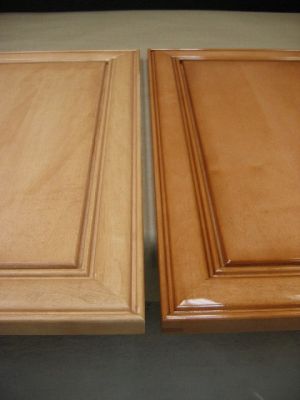Staining, Toning and Shading Maple
More discussion on the fine points of obtaining even color effects on maple. April 30, 2006
Question
I have a maple kitchen to finish. The customer wants a cinnamon color. I tested a stain (oil base) on a scrap, but of course there was no shortage of ugly splotching. I'm now going to try spraying a Behlen Solar-Lux ngr stain. Can anyone save me experiment time and tell me what color of Solar-Lux to use to achieve the cinnamon color? I have only seen a handful of colors available.
Forum Responses
(Finishing Forum)
From contributor J:
Try a wash coat of dewaxed shellac (Zinsser Seal Coat). That should help prevent the blotching and even out the stain. Paul Snyder has a great article that explains the process.
Related article: Wash Coats
From contributor M:
You might want to learn how to spray the stain. It take some practicing. Start by reducing the air pressure, and don't flood the stain. Allow to flash, and then uniform the stain. With some testing, you will find your way.
From contributor L:
I just went through the maple thing. I used a stain base without the pigment added, essentially a clear stain. Put this on and let it dry for the normal time on the can. Treat it just like a wiping stain, put it on and wipe it off, let it dry. This will condition the wood and slow the stain absorption. You may need to darken the stain color you are applying because it will come out lighter than if you stained raw wood. You can also darken it with a toner after the stain is applied. Worked well for me.
From contributor M:
That is one way to go, similar to using a wash coat of shellac, or a glue size. You're basically sealing the wood to prevent blotching. The stain will look lighter because it's laying on the top of the stain base. You need to darken the stain to compensate. A coat of boiled linseed oil will also work, and add a touch of color to the wood.
From Paul Snyder, forum technical advisor:
I'm not sure what color you have in mind when you say "cinnamon," but ML Campbell has a stain by that name that works well on difficult woods like maple. Behlen has an NGR dye with "cinnamon" in the name, but it's very orange looking to me.
One technique that I use to reduce the look of blotchiness is to reduce the stain with the clear stain base and use that on the bare wood. Reduce the stain enough to get rid of the blotchiness. Next, seal the lightly stained wood with a wash coat. Then to get the rest of the color, mix some of the stain in with some thinned finish and spray it over the smoothed sealer as a toner. Finally, a couple clear coats and you're done.
I used this technique on these maple doors. The one on the left has a reduced stain applied to the wood and the one on the right has toner and glaze added. The glaze is limited to the raised beads on this sample, but you could use it over the entire surface if you wanted the added color.

From contributor M:
I would consider that a shading stain. Color and coating in each application to build the finish.
From the original questioner:
Thank you for sharing your thoughts on finishing maple. I am a cabinetmaker and do my own finishing, but I've only used clear coats on maple. Thank you, Paul, for the picture - the proof is in the pudding, so I will try it your way.
From contributor S:
Be careful with the adding of stain to your finish that Paul mentions. Depends on stain type and its relationship to the coating...
From contributor O:
Paul, you mention adding stain to finish for a toner: "Then to get the rest of the color, mix some of the stain in with some thinned finish and spray it over the smoothed sealer as a toner."
Is the stain oil based? If so, can you give guidelines for how much thinner to add to make it compatible with the finish? We typically use MLC Woodsong II oil stains and WW Vinyl, DuraVar, Krystal.
From contributor S:
Don't do this, especially with Woodsong stains. Have your distributor mix you up a shading lacquer concentrate. They will use the same ingredients in your stain, leaving the stain base out, and reducing it with lacquer thinner so that you can safely add to your seal or topcoat.
From contributor O:
Thanks. I'll try that out. Too bad you can't just mix in the oil.
From contributor G:
Double check with your MLC distributor. I think that there's a safe percentage of WSII that can go into MLC clears. The shading concentrate is a good idea, but only works for stains that are formulated from scratch. Sometimes the stain matcher will just kick over an off the shelf stain.
From Paul Snyder, forum technical advisor:
I use oil-base stains like Woodsong without any problems. I'd probably use it in the vinyl sealer rather than the CV. If you use too much petroleum distillate (oil-base) products in your finish, compatibility is an issue. To avoid the problem, I typically mix 1-2 ounces of stain into about 28 ounces of lacquer thinner (or acetone) and then add a few ounces of finish (lacquer, vinyl, etc.). This produces a light colored toner/shader with very low solids. I sandwich it between coats of finish. It's a very thin layer.
From contributor O:
Thanks for the information. We'll try it.
